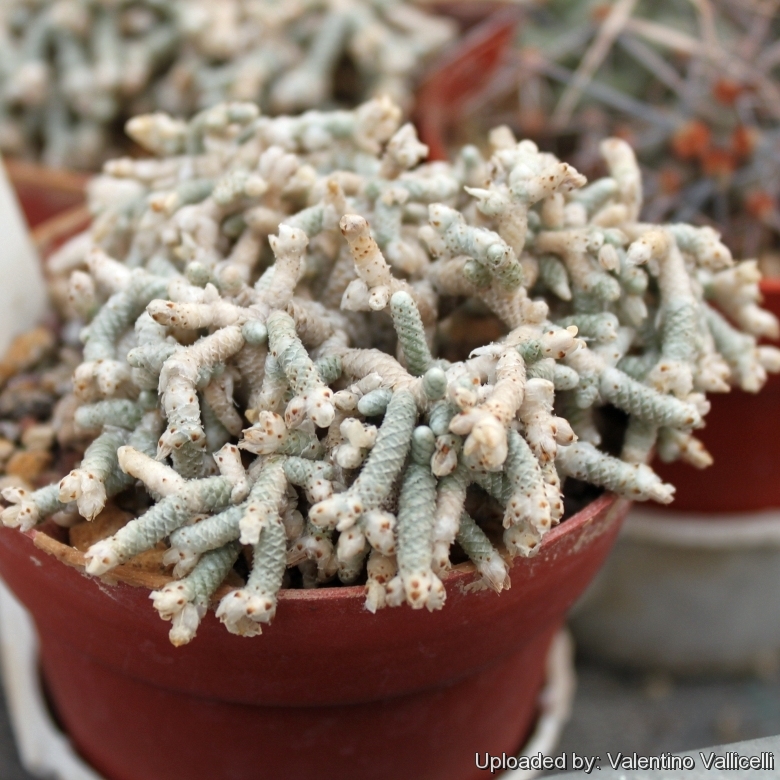




Your support is critical to our success.
- Encyclopedia of SUCCULENTS
- Encyclopedia Index
- Families
- Genera
- Species
- Portulacaceae
- Anacampseros
- Caudiciforms
Since 4 Aug 2013
Fl. Cap. (Harvey) 2: 383. 1862 [15-31 Oct 1862]
Family: PORTULACACEAE
Accepted Scientific Name: Avonia ustulata (E.Mey. ex Fenzl) G.D.Rowley
Bradleya 12: 112 (prepr. 4 July 1994)

Origin and Habitat: South africa. Avonia ustulataSN|11042]]SN|25182]] has a wide rangein the Great Carroo (Bloedrivier, warteruggens, between Uitenhage and Graafreynet, Gamkarivier), occurring also on the Nieuwveld.
Habitat: It grows on grey or yellowish shales of the Karoo, and is dull coloured to blend with the background, while related species like Avonia papyraceaSN|25182]]SN|11042]] are comparatively much more white. It mimic bird droppings as a camouflage strategy and helps it to survive.
Synonyms:
- Avonia ustulata (E.Mey. ex Fenzl) G.D.Rowley
- Anacampseros ustulata E.Mey. ex Sond.
CHINESE (中文): 褐蚕
Description: Avonia ustulataSN|25182]]SN|25182]], previously known as Anacampseros ustulataSN|25183]]SN|25183]], is a tiny succulent shrub with tufted silvery-grey worm-like branches.
Caudex: 6-8 mm in diameter more or less developed caudex partly underground, much branched from the base.
Primary branches: About 2,5 cm long, barely 2 mm in diameter, straight or tortuose, densely covered with closely imbricated papery scales (stipules) dichotomously divided, branches shorter.
Sterile stems: Bud-like, globular, ovoid or cylindrical mostly 3-4 mm long.
Fertile stems: 8-12 mm long, sometimes with one or a few similar branches.
Stipules: Very minute, silvery-grey, broad, ovate-triangular, acute, closely adpressed, those of the fertile stems with a patent rusty-brown but white-margined apex. The papery stipules protect it from the sun.
Leaves: The true leaves of this strange little plant are minuscles and hidden by the papery scales.
Flowers: Small, terminal, pale cream, equalling the involucre. Involucre 2 mm long, twice shorter than the 3-valved capsule.
Blooming season: Summer. The flowers open only in hot weather for a short time in the afternoon.
Bibliography: Major references and further lectures
1) William Henry Harvey, O. W. Sonder “Flora Capensis: Being a Systematic Description of the Plants of the Cape Colony, Caffraria, and Port Natal” Volume 2, 1862
2) Urs Eggli “Illustrated Handbook of Succulent Plants: Dicotyledons” Springer, 2002
3) Ben-Erik Van Wyk, Nigel Gericke “People's plants: a guide to useful plants of Southern Africa” Briza, 2000
Cultivation and Propagation: Although regarded as a choice and difficult plant, in cultivation it is relatively easy. It is a particular favourite of caudiciform plant enthusiasts.
Growth rate: Plants grow very slowly and caudex take many years to enlarge. Clustering in cultivation, if grown correctly, it will reward the grower with generous displays of tiny flowers.
Caudex exposure: The remarkable tuberous rootstock (caudex) is usually raised above the soil line so that this can be seen and more readily appreciated. For best results the tuber must be exposed only when plans become mature enough, usually after several years (8-12 or more years) of underground growth, as the exposed caudex will no longer increase in size once it has been lifted above the soil line.
Potting medium: Since roots are quite shallow, use a cactus mix or add extra perlite or pumice to regular soil potting soil. A gritty, very free-draining compost is suitable, and clay pots help the plants to dry out between watering. For best results, use a shallow pot, and only use the smallest diameter pot that will accommodate the plant.
Fertilization: Need a perfect fertilizer diet in summer. Use preferably a cacti and succulents fertilizer with high potassium content including all micro nutrients and trace elements or slow release fertilizer.
Watering Needs: Water normally in the growing season from March to October. No water should ever be allowed to stand around the roots. Keep almost completely dry in winter. The swollen caudex makes it very tolerant of under watering.
Hardiness: It is quite frost resistant if kept dry, hardy as low as -5° C. It can be grown outdoors in the summer months to benefit from direct exposure to light, and especially exposure to high summer temperatures.
Sun Exposure: This plant has an excellent heat tolerance, and need full sun to light shade exposures. High levels of light are needed to flower and for good plant development.
Rot: Rot it is only a minor problem with Avonia if the plants are watered and “aired” correctly. If they are not, fungicides won't help all that much. The plant turns immediately to mush when over watered, or watered out of season. Care must be given in watering, keeping them warm and wet while growing, and cooler and dry when dormant.
Traditional uses: The dried and pulverized roots and stems were once used as yeast for backing bread and also to brew mead (Honey beer). The fresh corms were also used to treat diabetes
they was crushed, boiled and ½ of a cup of decoction taken orally
Reproduction: The seed will loose viability in storage, and may not be viable the following year, so the seed should be planted as soon after harvesting as possible. Germination usually occurs within about a week or two. Seed germinate at 15-21 °C.
| Your Actions | |
|---|---|
| Back to Anacampseros index | |
| Back to Portulacaceae index | |
 |
Back to Succulents Encyclopedia index |
Privacy stantement - Terms and conditions - How to cite - About us - Feedback - Donate



